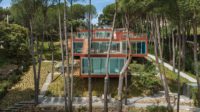Lakeside Retreat
Peter Gluck's modern take on the Adirondack Great Camp with two landform buildings that become part of the scenery.












































Architects & Firms
Adirondack Mountains, New York
Some minimalist architects boast that given enough money, they can make their architecture almost disappear. Although that claim seems to go against normal expectations about what so many architects really like to do, it often tempts those faced with a large program and a sensitive site.
Peter Gluck, for example, argues that creating an “experience” rather than building a visibly defined object should be an architect's supreme goal. With his recently completed Lakeside Retreat in New York's Adirondack Mountains, Gluck was able to prove his point—practically embedding in the earth 21,700 square feet of residential spaces for living and recreational uses. Conceptually and programmatically, the two buried buildings—a family house and a recreation building with an interior courtyard, amphitheater, gallery, and indoor pool—are essential pieces of a compound on a steeply sloped 21-acre site. The entire grouping, with two guest houses and abundant walking trails, and culminating in a 2,200-square-foot boathouse and dock, fulfills the same purpose as the nearby Adirondack great camps that cropped up in the mid- to late 19th century. The difference here in designing this family getaway, says Gluck, is that this project is done “without recreating the specific iconography of that period.” Indeed, other than the use of local materials, the buildings share no physical resemblance to their log-and-stone Swiss Chalet–style predecessors.
Visitors arrive first at a 4,800-square-foot gatehouse garage removed from the compound, where they swap vehicles for electric golf carts. Then they proceed along descending paths that lead to two 1,600-square-foot, one-bedroom guest houses—complete with small kitchens and composed of stacked and rotated boxlike volumes.
Heading on toward the lake, visitors catch glimpses of angular main buildings that appear and disappear in the topography of the sloping site. Foundations and floor slabs and walls are concrete with requisite waterproofing and underground drainage. By placing so much living and recreational space underground, the architect reduced energy loads with passive geothermal heating and cooling. Rainwater is retained via the green roof areas.
In the recreational building, dappled light from wood-screened windows and a skylight illuminate the lap pool. The family house with its master suite is more private, but it connects to nature with, for example, sleeping porches. “The entire project can be understood only by experiencing it sequentially,” Gluck says.
PeopleOwner: Withheld by client request Completion Date: May 2010 Gross square footage: Withheld by client request Total construction cost: Withheld
Architect:
Personnel in architect's firm who should receive special credit: Interior designer: Holmes Newman and Partners
Engineer(s): Civil Engineer: Jarrett-Martin Engineers Structural Engineer: Robert Silman Associates P.C. MEP Engineer: IBC Engineering Services, Inc.
Consultant(s)
Acoustical: Paul Scarbrough Audio/Visual: HEDsouth Construction Manager: ARCS Construction Services, Inc.
Photographer(s)
CAD system, project management, or other software used: |
Products
Structural system
Exterior cladding
Roofing
Doors
Metal frame and support fabrication:
Custom Mahogany Exterior doors:
Hardware
Interior finishes
Special surfacing:
Floor and wall stone tile: Pool glass tile and sauna stone tile installation: VSI
Fireplace soapstone slabs and fabrication: Main House Stair fabrication: Residence Artists, Inc.
Main House Stair Treads:
Main House Stair Tension Rods:
Boathouse Dock Ipe Deck & Steel Fabrication: |
























